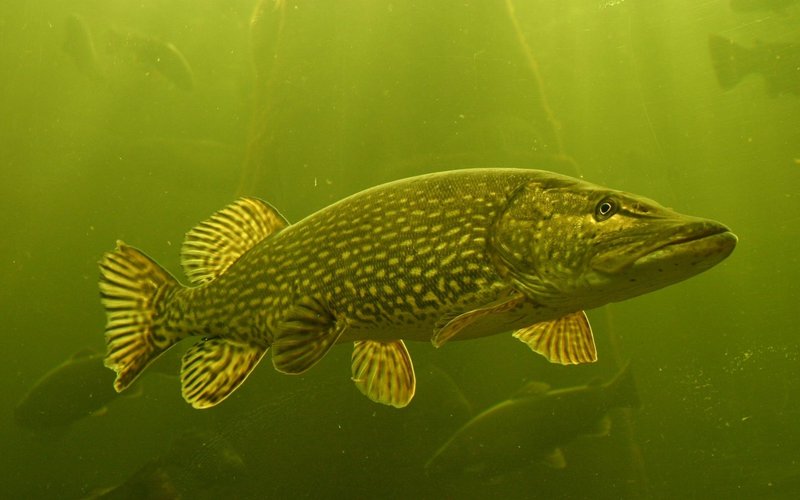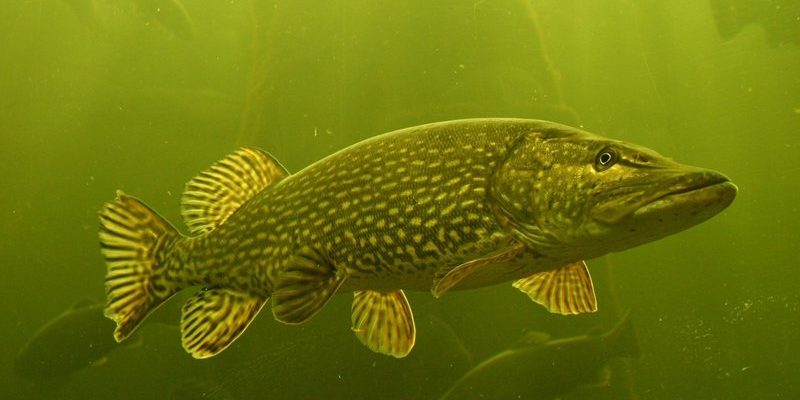
Imagine stepping onto the edge of a shimmering lake, the sun sparkling off the surface like a thousand tiny diamonds. As you peer into the clear water, you might catch a glimpse of something sleek and powerful darting beneath the surface. That’s the Northern Pike, a fascinating fish that reigns as one of the ultimate predators in North America’s freshwater ecosystems. With its long, torpedo-shaped body and razor-sharp teeth, the Northern Pike doesn’t just swim; it rules its domain.
Northern Pike can be found lurking in lakes, rivers, and marshes, often hiding among vegetation and submerged structures. Known for their aggressive nature and impressive hunting skills, these fish can grow to significant sizes, making them a popular target for anglers seeking the thrill of the catch. But there’s much more to these incredible creatures than just their sharp teeth and impressive size. Let’s take a closer look at what makes the Northern Pike such a captivating species.
Physical Description
When you first see a Northern Pike, you might be struck by its elongated body and distinct coloration. Generally, these fish can be recognized by their greenish hue with light, sporadic spots that help them blend seamlessly into their surroundings. This camouflage is their secret weapon, allowing them to ambush unsuspecting prey. Adult Northern Pike typically range from 20 to 40 inches in length, although some impressive specimens can reach over 50 inches!
Their dorsal and anal fins are positioned far back on the body, with the caudal fin (tail fin) being wide and deeply forked. This unique fin structure gives them remarkable speed and agility in the water, helping them to launch surprise attacks on their prey. You might think of them as the Formula 1 cars of the fish world; built for speed and performance. And let’s not forget those teeth—they are razor-sharp and designed for grabbing slippery fish, making it nearly impossible for their dinner to escape.
Interestingly, as they age and grow, Northern Pike can display variations in color and size. Younger pike tend to be more brightly colored, while older ones may take on a more muted tone. This evolution in appearance not only serves aesthetic purposes but also helps them adapt to their changing environments as they grow.
Habitat and Distribution
Northern Pike are incredibly adaptable, thriving in a variety of freshwater habitats across North America, Europe, and Asia. You’ll find them in lakes, rivers, and wetlands, often favoring areas with ample vegetation or submerged structures. This type of environment offers plenty of hiding spots for them to stalk their next meal. In summer, they tend to migrate into shallower waters to spawn, while in winter, they may move to deeper areas where the water is warmer and more stable.
From the clear waters of the Great Lakes to the murky marshes of the Mississippi River, the Northern Pike has carved out a diverse range of habitats. Their presence varies significantly based on regional climates and water conditions, which can influence their breeding habits and feeding patterns. It’s always exciting to spot one of these magnificent creatures in the wild, especially knowing their preferred hangouts.
This adaptability also means Northern Pike can coexist with other species, often serving as both predator and prey within their ecosystems. However, they can also face competition and threats from invasive species, habitat destruction, and overfishing, making conservation efforts vital for their continued existence.
Diet and Feeding Behavior
The Northern Pike is a true carnivore and an apex predator, primarily feeding on smaller fish, such as perch, minnows, and even small pike. They are known for their ambush-style hunting, lying in wait among the weeds or submerged structures until they spot an unsuspecting fish. When the moment is right, they strike with lightning speed, using their sharp teeth to grasp and immobilize their prey. This feeding strategy is similar to the way a cat might pounce on a mouse—swift and precise.
Interestingly, Northern Pike can also eat amphibians, birds, and small mammals when the opportunity arises. Their opportunistic feeding habits ensure they remain at the top of the food chain. You might be surprised to learn that they can consume prey that is nearly half their body size, demonstrating their incredible strength and hunting prowess.
As the seasons change, so do their feeding patterns. In spring and summer, when the water is warmer and prey is more abundant, they are more active hunters. In colder months, however, they may slow down, relying on stored energy to get through the season. It’s a fascinating example of how these fish adjust their behavior in response to environmental conditions.
Reproduction and Lifespan
Northern Pike typically spawn in the early spring when water temperatures rise to around 40 to 50 degrees Fahrenheit. During this time, you might find them moving into shallow, weedy areas of the lake or river where they can lay their eggs. The female pike can deposit thousands of eggs, which stick to vegetation and provide a protective environment for the developing fry. This is like a nature-made nursery, ensuring that the young fish have a safe start to life.
Once the eggs are laid, they hatch in about 10 to 14 days, and the tiny fry remain close to the vegetation for protection as they grow. It’s a delicate balancing act, as many of these fry will fall prey to larger fish, birds, and other predators. However, if they can survive those early days, they can grow rapidly in their first few years, reaching about a foot in length within just a year.
As for lifespan, Northern Pike can live up to 10 to 15 years in the wild, although some individuals have been known to reach 25 years or more in ideal conditions. That longevity allows them to become formidable hunters over time, passing on their survival skills to the next generation.
Conservation Status
The Northern Pike plays a crucial role in freshwater ecosystems, but it’s important to be aware of the challenges they face. While they are currently not considered endangered, their populations can be affected by habitat loss, pollution, and overfishing. In some areas, invasive species compete for resources and can disrupt the balance of the ecosystem. Therefore, many regions have implemented fishing regulations and conservation measures to protect Northern Pike habitats.
Efforts such as spawning habitat restoration and catch-and-release fishing practices are crucial to maintaining healthy populations. Anglers can play an important role by adhering to size and bag limits, ensuring that the pike can reproduce and thrive. Just like taking care of a garden, protecting these habitats helps foster a vibrant ecosystem where Northern Pike can flourish alongside other species.
Education and awareness are also key components of conservation. By understanding the importance of this species and the challenges it faces, we can work together to ensure that Northern Pike remain a prominent feature of our freshwater landscapes for generations to come.
| Attribute | Description |
| Scientific Name | Esox lucius |
| Size | Typically 20 to 40 inches, some over 50 inches |
| Weight | Up to 55 pounds |
| Habitat | Lakes, rivers, marshes |
| Diet | Fish, amphibians, birds, small mammals |
| Lifespan | 10 to 15 years in the wild; up to 25 years in ideal conditions |
Fun Facts about Northern Pike
Now that you’re familiar with the essential details about Northern Pike, let’s dive into some fun facts that might surprise you. For starters, did you know that a Northern Pike can swim at speeds of up to 10 miles per hour? That’s equivalent to a human sprinting at top speed! This ability grants them an advantage when chasing prey or escaping threats.
Another interesting tidbit is that Northern Pike have a unique social structure. They are typically solitary creatures but can occasionally be found in small groups during feeding times or mating seasons. It’s a reminder that even apex predators can have moments of social interaction, albeit brief.
Lastly, the Northern Pike has been a subject of fascination in various cultures. In Native American mythology, the pike symbolizes strength and resilience, reflecting its formidable nature. This cultural significance further adds to the allure of this amazing fish.
FAQ
What is the best time to fish for Northern Pike?
The best time to fish for Northern Pike is typically during the late spring and early summer months. This is when they are most active and can be found in shallower waters during their spawning season. Early mornings and late afternoons are particularly fruitful, as this is when they are hunting for food.
Are Northern Pike dangerous to humans?
While Northern Pike are powerful predators with sharp teeth, they are not dangerous to humans unless provoked. It’s always best to handle them carefully if you’re fishing, as they may bite if intimidated. Overall, they are more interested in feeding on smaller fish than causing trouble for people.
How can I identify a Northern Pike?
You can identify a Northern Pike by its long, sleek body, pointed snout, and distinctive coloration—green with lighter spots. Their dorsal fin is positioned far back near the tail, and they have sharp teeth that are designed for grasping slippery prey. These characteristics set them apart from other fish species found in freshwater.
What do Northern Pike eat?
Northern Pike primarily eat smaller fish, such as minnows, perch, and other species. However, they are opportunistic feeders and may also eat amphibians, birds, and even small mammals if the chance arises. This diverse diet helps them adapt to different environments.
Can Northern Pike be kept in aquariums?
While it’s possible to keep Northern Pike in large aquariums, it’s not generally recommended. They require a lot of space and specialized care, along with a diet suitable for their carnivorous nature. If you’re considering keeping a pike, ensure that your aquarium can accommodate its size and behavior.
Why are Northern Pike important for the ecosystem?
Northern Pike play a vital role in freshwater ecosystems as apex predators. They help control the populations of smaller fish and maintain a balanced food web. Their presence indicates a healthy ecosystem, and protecting them supports overall biodiversity.
Are there any regulations for fishing Northern Pike?
Yes, many regions have specific regulations regarding Northern Pike fishing. These can include size limits, bag limits, and specific seasons for fishing. It’s crucial to check local laws and adhere to them to ensure sustainable fishing practices.
How fast can Northern Pike swim?
Northern Pike can reach speeds of up to 10 miles per hour. This speed is useful for catching prey and evading larger predators. Their streamlined bodies and powerful tails contribute to their remarkable agility in the water.
What are some common threats to Northern Pike populations?
Common threats to Northern Pike populations include habitat loss due to pollution, water development, and invasive species that compete for resources. Overfishing can also pose a significant threat, making conservation efforts all the more important for sustaining healthy populations.
Can I eat Northern Pike?
Yes, Northern Pike are edible and considered a delicacy in many regions. However, care should be taken when filleting them due to their numerous small bones. Cooking methods such as baking, grilling, or smoking can highlight their mild flavor and make for a delicious meal.
How do Northern Pike adapt to seasonal changes?
Northern Pike adapt to seasonal changes by altering their feeding patterns and habitat preferences. In warmer weather, they move to shallow waters to spawn, while in colder months, they shift to deeper areas with stable temperatures. This adaptability helps them thrive in various environments throughout the year.

